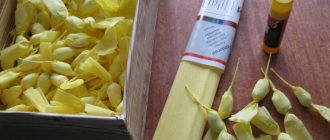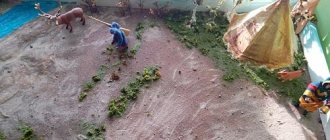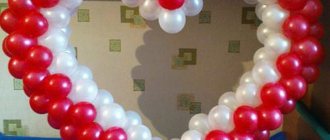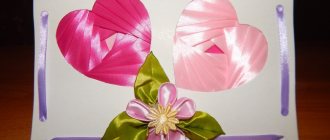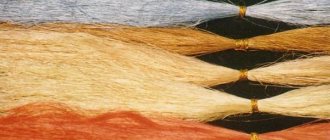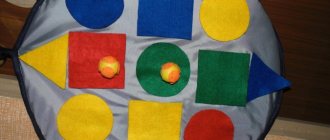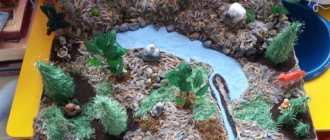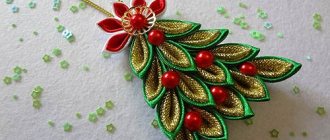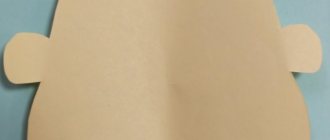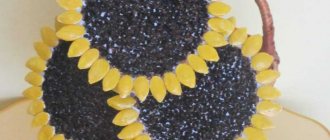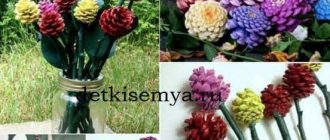Master class on making flannelgraph
Lushnikova Marina Valentinovna
Master class on making flannelgraph
Making flannelgraph.
Master Class . Lushnikova M.V. – teacher.
a flannelgraph in my group , but getting plywood and flannel is still half the trouble, it is necessary for someone else to process this plywood. And flannel lately has mostly only been colored. Once I saw on the Internet a didactic game for children 2-3 years old on a flannelgraph . I really liked this idea and decided to make one for myself for theatrical activities with children from 3 to 5 years old. And this is what I got.
I took two viscose napkins for the floor, a lid from a cardboard box, braid, and Velcro.
I sewed the napkins on three sides on a sewing machine and turned them inside out.
The result is an envelope like this.
I inserted cardboard into the inside of this envelope, folded the edges and stitched it on a typewriter.
This is what happened.
Then I stitched a braid along the edges to give the flannelgraph completeness .
This is the flannelgraph I got .
Then I took Velcro (hard half of Velcro, double-sided tape, pictures printed on thick paper (pictures can be drawn, or cut out from old books or coloring books)
.
I glued the Velcro onto tape and then onto pictures (pictures can be glued to calico or chintz fabric)
.
Here's what I got.
I was so fascinated by this idea that I made two smaller ones for educational games.
Tale of the winter hut of animals.
Flannelograph can be used for theatrical activities, in children's independent play activities, in classes, and for playing educational games.
Master class on making a drum Dear colleagues, it is no secret that the material resources in many kindergartens are not rich. children. They come to kindergarten in the morning and leave in the evening. Master class on making pencil holders. Dear colleagues! Today I want to share with you my experience in making pencil holders. I have kids and therefore this item. Master class on making maracas I would like to present to your attention a master class on making macaras. Maracas are the oldest percussion and noise instrument of the indigenous people. Master class on making board games We all face the fragility of cardboard. I bring to your attention my idea of creating DURABLE board games. You will need: 1. Master class on making a sunflower For work you will need: scissors, colored crepe paper, a glue brush, glue, black cardboard, cardboard for a template, a board, a stick. Master class on making roses Master class on making roses from corrugated paper. Dear Colleagues! Mother's Day is approaching. I would like to introduce. Master class on making snowmen Finally, I succumbed to the New Year's mood and decided to make these handsome snowmen. To begin with, we were charged with optimism. Master class on making snowflakes As a child, we were taught to cut out snowflakes from paper folded several times. But personally, no matter how much I cut out, I end up with snowflakes. Master class on making “Hedgehog” crafts Good evening, dear colleagues! I want to share with you a little experience in making a hedgehog from maple seeds. I needed it for registration.
Source
Flannelograph: why is it needed and how to make it -
You can’t do without a flannelgraph if parents want to engage in didactic and educational games with their kids at home, without visiting children’s clubs and centers. You can actually make this device yourself, but we’ll look at how later.
Flannelograph is...
A sheet of cardboard or plywood covered with flannel (carpet, fleece - as options) fabric is a so-called flannelgraph. Depending on the type of stand, the device can be floor-standing, like an easel, or tabletop like a tablet. It is important that the surface of the flannelgraph is located at a slight angle towards the children who are practicing.
During classes, figures and pictures are placed on the flannelgraph plane, which are fixed on the fabric surface with adhesive tape or, less often, with double-sided tape - whatever is at hand.
At what age should you practice flannelography?
The device will serve for decades, it is suitable for classes with children aged one year and older, and it can be used for the development of a child until he enters 1st grade.
Such a long service life is due to the fact that flannelgraph is inherently a universal board for many types of games, activities and even tabletop puppet shows.
How to make a flannelgraph for a child yourself
If you are making a flannelograph for a 2-3 year old child, you can really involve him in this creative work.
For the craft you will need the following materials
List:
- a sheet of plywood, cardboard or alternative materials of suitable size (it is possible to make several options with different sheet areas);
- textile;
- zip fastener;
- thread, needle, scissors (if available - sewing machine).
You will need enough fabric to wrap one surface of the sheet completely, making folds to the other edge. The result is something like a removable cover on a plywood sheet. Or, as an option, make a whole double-sided case with one side fastened with a zipper.
Figures and pictures for activities
Traditionally, modern parents “get” pictures for various games and activities by downloading images on the Internet. We recommend this method as the most convenient: the choice of material is huge, there is practically no hassle in implementation - find it, print it, cut it out.
On the reverse side of each figure, it is necessary to glue a small piece of the material that was used on the flannelgraph itself - this ensures reliable adhesion between the surfaces of the sheet and the figures, which does not prevent them from being easily removed from the flannelgraph.
It is also possible to draw pictures and figures yourself, or use ready-made children's themed stickers.
Advice from experienced parents: to make the pictures last longer, before cutting out the design from the sheet, make an improvisational lamination of the surface of the paper by gluing transparent tape to it.
How to practice with flannelgraph
Each lesson must have its own figures. For example, for mathematics these will be geometric figures and numbers, for the Russian language or reading - letters, for logic classes - thematic selections of different figures.
What knowledge parents are going to develop in their children, such material must be prepared for classes.
So for the first lesson, be sure to prepare figures from some simple fairy tale, for example, “Kolobok”, “Rock Chicken”, “Turnip”. So that children do not associate the flannelgraph only with activities, but also associate it with games.
Game "Make a picture"
One of the most interesting educational activities can be the “Make a Picture” game. Prepare a lot of thematic figures that could be laid out on the flannelgraph together so that a logical plot is obtained.
For example, it could be a house with a yard, a garden, a path going past into the forest, sun and clouds. The child is required to compose a picture so that the objects are each in its place.
By preparing several thematic selections, you can captivate children for a long time with activities that they will perceive as games.
Game "Puppet Theater"
Together with your child, you can prepare performances performed on a flannelgraph. Moreover, the child can participate at any stage, including preparation.
Trust him to select suitable pictures of the main characters on the Internet, perhaps the child will be able to carefully cut out the figures of future dolls. You can use your favorite fairy tale as a script or write your own actions and scenes.
This is how it is possible to develop a sense of beauty in a child.
Master class “Theater on flannelgraph”
Eleonora Pereverzeva
Master class “Theater on flannelgraph”
Theater on flannelgraph.
I present to your attention a theater consisting of two fairy tales: “Turnip” and “Kolobok”. I needed:
- solid cardboard - 2 sheets
-printed fairy tale characters (can be taken from old books)
-plain wallpaper (whatman paper is possible)
-viscose cloths for cleaning
- Velcro tape (rough part)
-nylon thread (to hang curtains)
1. Cover the cardboard with wallpaper or whatman paper so that the gray cardboard does not show through.
2. Iron viscose rags so that there are no creases or folds.
3. Place the viscose rags, see how they fit, select the desired position and glue with double-sided tape.
4. Cut out grass from green cardboard and green viscose, glue the cardboard first, then the viscose.
5. From a gift bag (can be from something else)
cut out the flowers, arrange them and then glue them on.
6. String the curtains onto a nylon thread, gather them together, fix them and glue them, leaving the long ends of the thread on the back of the cardboard.
7. Tie the curtains with ribbons.
8. Coat the other half of the cardboard well with glue (you can use construction glue, such as “Dragon”; it does not dry so quickly and fixes well)
9. Cut out the figures of animal characters not along the contour, glue them onto white cardboard, and then cut them out. (this will make it easier to cut out small parts)
10. Glue adhesive tape (the rough part)
The theater is ready!
Master class “Paper Puppet Theater” In search of an alternative to a harmful hobby, adults often forget about such a magical art as puppet theater. After all, to the performances. Master class “Papier-mâché puppet theater” Good day, dear colleagues! Today I want to introduce you to my work. The idea of making a puppet theater is long gone. Master class “Do it yourself puppet theater” Master class “Do it yourself puppet theater” Theater for a child is not only a journey into the magical world of a fairy tale, it is a source of knowledge.Master class “Do-it-yourself finger theater” As part of the implementation of the city project “Reading Together”, a master class in the form of a quest “Do-it-yourself theater” was organized in the kindergarten.
Master class “Glass Theater” Master class “Glass Theater” Prepared and conducted by the teacher of the Municipal Preschool Educational Institution “Kindergarten No. 4” in Saratov V. S. Khlopushina. In the second half of the year. Master class “Theater on Spoons” Theatrical activities give the child joy and are one of the most effective ways of corrective influence in which. Master class “Clothes pegs theater “Geese and swans” Master class: Clothes pegs theater “Geese and swans”. One of the ways to develop dialogical speech is theatrical activity. The most important. Master class “Animal Theater on Ice Cream Sticks” To create a wide variety of crafts, in addition to natural and various specially purchased materials, you can use the so-called. Master class “Shadow Theater Kolobok” I bring to your attention a master class on making a shadow theater “Kolobok”. The idea of creating a shadow theater inspired me when I was old.
Source
Table flannelgraph made of felt
With your own hands you can make a wonderful game that teaches traffic rules. A background is cut out of a black sheet, a road with intersections and small yellow stripes for markings are made from blue felt.
The details of the game are sewn separately - these are multi-storey buildings, various cars, trees, pedestrians. You can cut out road signs and traffic lights. Both the flannelgraph and the templates are easy to make with your own hands. Any experienced teacher can handle it. The main goal of this game is to teach children the rules of behavior on the road, the ability to cross the street in the right place and know the basic road signs.
Flannelograph “In the world of fairy tales”
Danilova Nina Viktorovna
Flannelograph “In the world of fairy tales”
Materials: Flannelgraph (made from improvised means: a box covered with flannel , various fairy-tale characters based on Russian fairy tales (Kolobok, Teremok, Turnip, Wolf, New Year's Tree., objects (Sun, clouds, raindrops.)
.
And the most interesting thing is that our children can create a new fairy tale from two well-known fairy tales , their own fairy tale with heroes .
1. Games to develop attention and memory, speech (What is superfluous, What has changed)
2. Thematic games (Name of Russian fairy tales )
3. Themed games (Insects)
And in conclusion, our flannelgraph can be used to read fairy tales , the teacher reads a fairy tale and at the same time shows it on the flannelgraph , children easily learn the fairy tale and remember it .
The main thing is unusual and interesting!
Album on speech development “In the world of fairy tales” Introduction. A fairy tale is an amazing phenomenon of folk art. Simple and uncomplicated in appearance, it is interesting for both small children and adults.
Entertainment scenario within the framework of the project “Baby in the world of fairy tales” for young children 2–3 years old “Visiting fairy tales” Goal: to consolidate children’s knowledge about Russian folk tales and create a joyful mood when communicating with adults and peers. Progress of entertainment:.
Project in the second junior group “In the world of fairy tales” Developed by: Senior teacher of MBDOU kindergarten No. 5 Gerasimenko Yu. E. Project type: informational and game. Duration: short term.
Travel Quiz (KVN) “There are many fairy tales in the world” Purpose: To expand children’s knowledge about well-known fairy tales; cultivate goodwill, the ability to work in a team, improve communication skills.
Sports festival “In the world of sports and fairy tales” Sports festival “In the world of sports and fairy tales” Educator: Hello, golden sun! We spread our arms to the sides, like the rays of the sun. Hello,. Flannelgraph theatre. Showing fairy tales for the first junior group Topic: flannelgraph theater for the first junior group showing fairy tales. Flannelograph Theater. It is the easiest to make and display. Images.
Source
Do-it-yourself didactic manual “Flanelegraph” for children 2–3 years old
Trusova Elena Sergeevna
Do-it-yourself didactic manual “Flanelegraph” for children 2–3 years old
Developed by Elena Sergeevna Trusova:
teacher at MBOU "Metalploshchadskaya Secondary School", kindergarten "Emerald City.
Flannelograph
- an educational visual aid, which consists of a game panel (this is a board or thick cardboard, covered with flannel or fleece, on which cut out figures are attached.
Age
: Recommended age: 1.5 years.
Description of material:
The manual is intended for the development of fine motor skills in children, sensory development, for theatrical, independent play activities of children in the classroom and didactic games. Can be used for individual work with children. The flannelgraph allows you to act out various scenes in front of children. The range of games that can be played on a flannelgraph is quite wide.
enrichment of children's sensory experience, development of tactile sensations, fine motor skills of the hands, development of cognitive and emotional spheres, spatial perception.
Tasks:
develop attention, memory, speech, imagination, auditory perception, tactile sensations, and the ability to correlate verbal and visual information.
Making a flannelgraph is very simple.
Required material:
The fabric I used is beige fleece, it has a long pile and the figures are attached well. Fabric size 55 by 55 cm
2 sheets of thick cardboard measuring 55 by 45 cm are the basis of the flannelgraph.
Double-sided tape, which I used to secure the fabric to the cardboard and glue the cardboard sheets together.
1 m of non-woven wallpaper, with which I wrapped 2 sheets of cardboard, for aesthetic perception.
Universal glue “Moment”, which I used for gluing fabric seams and gluing wallpaper to cardboard.
1 m of white satin ribbon, 1 cm wide, for attaching the flannelgraph to the wall.
Printed color pictures of fairy tale characters.
Velvet paper, which I glued to the back of the pictures and figures, for good adhesion to the fleece.
Wide tape that I used to cover all the figures to extend their use.
Making the board:
First, I took a sheet of thick cardboard and wrapped it in fabric. We attach the fabric and edges with double-sided tape, glue the corners and clamp them.
We wrap the second piece of cardboard with non-woven wallpaper and glue the edges.
We glue two sheets of cardboard together with wide double-sided tape, and glue the edges well. We clamp a satin ribbon between the sheets; I also sewed it to the fabric for good fastening. Then I put the flannelgraph under the press so that the glue dries well and all the parts are connected to each other.
So the flannelgraph is ready.
It took me about 1 hour to make it.
Making figurines:
Heroes of fairy tales: I found pictures on the Internet, printed them out on a color printer, then glued them onto velvet paper and covered them with wide tape on top.
Geometric shapes: I drew the shapes on colored cardboard, glued them to velvet paper, and covered them with wide tape on top.
Game “Grandfather Planted a Turnip”, “Teremok”, “Kolobok”, “Chicken”
develop speech, auditory perception, and the ability to correlate verbal and visual information.
Game material and visual aids:
flannelograph, characters from fairy tales: “Turnip”, “Kolobok”, “Teremok”, “Chicken”.
Description:
When telling a fairy tale, the teacher places figures on the board in accordance with the development of the plot. Then the teacher invites the child to place the figures on the board independently. During the game, the child names the characters of fairy tales. During the game, the teacher removes the figures and asks the child questions about the text, inviting him to put on the flannelgraph the hero of the fairy tale about whom they are asking. Then he complicates the task by asking about the characters not as they appear in fairy tales.
Didactic game for children 2-3 years old “Geometric shapes”.
development of children's sensory experience.
Tasks:
consolidate knowledge of primary colors (blue, red, green) introduce children to geometric shapes (circle, square, rectangle, triangle) and teach them to distinguish between them. Develop attention, thinking and visual perception.
Description:
The teacher places geometric figures on the board, and during the game asks the children what kind of figure it is and what color it is. Then ask the child to show a square, circle, triangle, rectangle. Invite your child to compare objects by shape, first place all the circles, squares, etc. Then select the shapes by color. During the game, you can say what is round (this is a ball), square (this is a window, triangular (this is a roof), etc.
"Houses for dolls." Do-it-yourself didactic manual. Master class In my work with preschool children, I try to include games for sensory development in all types of activities. Now in stores. "Colorful butterflies and flowers." Do-it-yourself didactic manual. Master class Continuing the theme of didactic aids for working with preschool children, I offer another master class on making an original one. "Zoocube". Do-it-yourself didactic manual for children of primary preschool age The manual was made with the aim of expanding children's knowledge about animals, consolidating knowledge about primary colors, developing children's attention and thinking. Do-it-yourself didactic games for children 3–4 years old Material prepared by: Tatyana Mikhailovna Eroshova, teacher of the second junior group. d/s "Firefly". Sensory education directed.
Didactic manual “Geometric figures on magnets” for children 4–6 years old Purpose: To promote the activation and enrichment of children’s experience in performing game tasks using the manual “Geometric figures on magnets”.
Didactic manual “Vegetable garden” for kindergarten with your own hands Didactic manual “Vegetable garden”. The main activity of preschoolers is play. Everyone knows that children love to play. Multifunctional teaching aid on FEMP for children from 1.5 to 4 years old. Flannelograph “Flowers-Butterflies” Material: felt, foamarin, satin ribbons, beads, Velcro Contents: flannelgraph size A3, five flowers, five corresponding butterflies. Do-it-yourself manual for the development of fine motor skills of a 4-5 year old child I would like to present to your attention an entertaining manual for the development of fine motor skills, memory, speech and attention “Baby Book” During work. Do-it-yourself manual for developing fine motor skills of a child from 1–3 years old I would like to present to you handmade crafts for developing fine motor skills in children. I use different materials for this: fabric,...
Source
Book-flannelograph for home use
Nowadays, soft books made of fabric are popular. They perform different learning tasks, each on a separate page. So, in the photo below, the page is sewn from cotton fabric, and Velcro is attached to it. The details of the pyramid are sewn from felt. The child assembles it independently, selecting parts as the size decreases.
Each page is sewn separately and then combined into one book by sewing on the cover and border. You can lay a thin layer of padding polyester between the layers of fabric.

